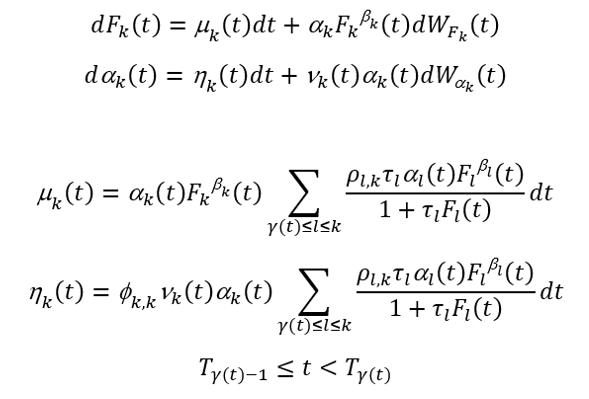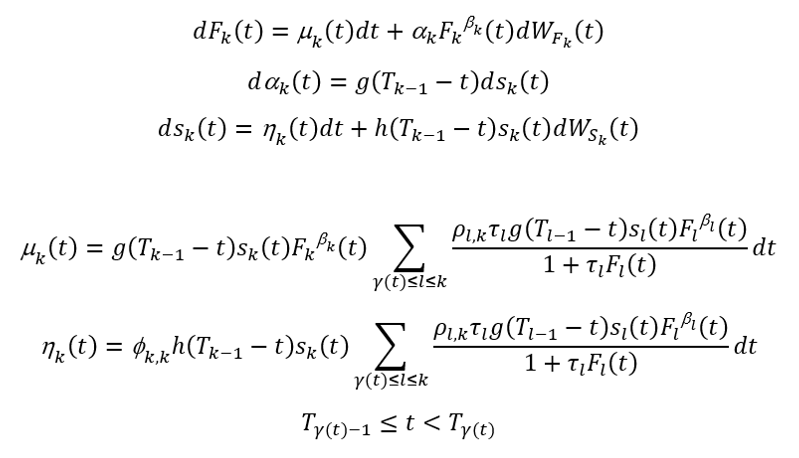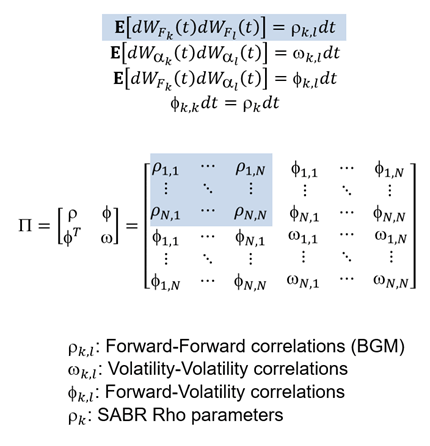SABRBraceGatarekMusiela
Create SABRBraceGatarekMusiela model object for
Cap, Floor, FixedBond,
FloatBond, FloatBondOption,
FixedBondOption, OptionEmbeddedFixedBond, or
OptionEmbeddedFloatBond instrument
Since R2021b
Description
Create and price a Cap, Floor,
FloatBond, FloatBondOption,
FixedBond, FixedBondOption,
OptionEmbeddedFixedBond, or
OptionEmbeddedFloatBond instrument object with a
SABRBraceGatarekMusiela model using this workflow:
Use
fininstrumentto create aCap,Floor,FixedBond,FloatBond,FloatBondOptionFixedBondOption,OptionEmbeddedFixedBond, orOptionEmbeddedFloatBondinstrument object.Use
finmodelto specify aSABRBraceGatarekMusielamodel object for theCap,Floor,FixedBond,FloatBond,FloatBondOption,FixedBondOption,OptionEmbeddedFixedBond, orOptionEmbeddedFloatBondinstrument object.Use
finpricerto specify anIRMonteCarlopricing method for aCap,Floor,FixedBond,FloatBond,FloatBondOption,FixedBondOption,OptionEmbeddedFixedBond, orOptionEmbeddedFloatBondinstrument object.
For more information on this workflow, see Get Started with Workflows Using Object-Based Framework for Pricing Financial Instruments.
For more information on the available pricing methods for a Cap,
Floor, FixedBond,
FloatBond, FloatBondOption,
FixedBondOption, OptionEmbeddedFixedBond, or
OptionEmbeddedFloatBond instrument, see Choose Instruments, Models, and Pricers.
Creation
Description
SABRBraceGatarekMusielaModelObj = finmodel(ModelType,Alpha=alpha_value,Beta=beta_value,VolatilityofVolatility=volatilityofvolatility_value,FwdFwdCorrelation=fwdfwdcorrelation_value,VolVolCorrelation=volvolcorrelation_value)SABRBraceGatarekMusiela model object
with null forward to volatility correlation by specifying
ModelType and the required name-value arguments
Alpha, Beta,
VolatilityofVolatility,
FwdFwdCorrelation, and
VolVolCorrelation to set properties
using name-value arguments. For example,
SABRBraceGatarekMusielaModelObj =
finmodel("SABRBraceGatarekMusiela",Alpha=Alpha,Beta=Beta,VolatilityofVolatility=VolVolFunc,FwdFwdCorrelation=FwdFwdCorrelation,
VolVolCorrelation=VolVolCorrelation) creates a classic
SABRBraceGatarekMusiela model object with null
forward to volatility correlation.
SABRBraceGatarekMusielaModelObj = finmodel(___,Name=Value)SABRBraceGatarekMusiela model:
To create a classic
SABRBraceGatarekMusielamodel object, use theFwdVolCorrelationname-value pair argument:SABRBraceGatarekMusielaModelObj = finmodel("SABRBraceGatarekMusiela",Alpha=Alpha,Beta=Beta,VolatilityofVolatility=VolVolFunc,FwdFwdCorrelation=FwdFwdCorrelation,VolVolCorrelation=VolVolCorrelation,FwdVolCorrelation=FwdVolCorrelation)To create a classic
SABRBraceGatarekMusielamodel object in Rebonato parametric form with null forward-to-volatility correlation, use theVolatilityname-value pair argument:SABRBraceGatarekMusielaModelObj = finmodel("SABRBraceGatarekMusiela",Alpha=Alpha,Beta=Beta,VolatilityofVolatility=VolVolFunc,Volatility=VolFunc,FwdFwdCorrelation=FwdFwdCorrelation,VolVolCorrelation=VolVolCorrelation)To create a classic
SABRBraceGatarekMusielamodel object in Rebonato parametric form withFwdVolCorrelation = CorrFunc(meshgrid(1:numRates-1)',meshgrid(1:numRates-1),.02), use theVolatilityandFwdVolCorrelationname-value arguments:SABRBraceGatarekMusielaModelObj = finmodel("SABRBraceGatarekMusiela",Alpha=Alpha,Beta=Beta,VolatilityofVolatility=VolVolFunc,Volatility=VolFunc,FwdFwdCorrelation=FwdFwdCorrelation,VolVolCorrelation=VolVolCorrelation)
Input Arguments
Name-Value Arguments
Output Arguments
Properties
Examples
More About
References
[1] Brigo, D. and F. Mercurio. Interest Rate Models - Theory and Practice. Springer Finance, 2006.
[2] Crispoldi, C., Wigger, G., and P. Larkin. SABR and SABR LIBOR Market Models in Practice. Palgrave MacMillan, 2015.
[3] Hagan, P. and A. Lesniewski. LIBOR market Model with SABR Style Volatility. Working paper JPMorgan Chase, 2008.
[4] Rebonato, R., McKay, K., and R. White. The SABR/LIBOR Market Model: pricing, Calibration, and Hedging for Complex Interest-Rate Derivatives. Wiley, 2009.
Version History
Introduced in R2021b



